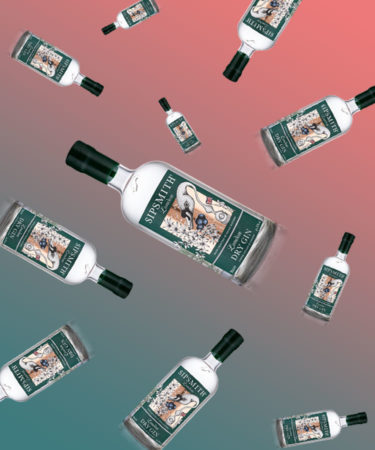When planning its boutique London gin brand in 2006, Sipsmith’s founders had simple yet bold ambitions: “to be available in a meaningful way in all four corners of the world, and to be around in 200 years’ time,” co-founder Sam Galsworthy said in 2018.
At the time, Galsworthy was working in the U.S. as a brand ambassador for Fuller’s Brewery, while co-founder Fairfax Hall (a fellow Brit and Galsworthy’s childhood friend), was completing a Diageo-sponsored MBA in Pennsylvania.
Noticing a growing trend for “craft” everything in the U.S. — “from micro-brewing to craft distilling and coffee roasting,” Galsworthy said — the pair began discussing a shared dream to launch a small-batch distillery in England’s capital. Getting started was no easy task.
From how the duo became a trio, to how the brand defeated archaic distillation laws, here are 10 things you should know about Sipsmith gin.
SIPSMITH HELPED CHANGE BRITISH DISTILLATION LAWS.
In 19th-century Britain, tax officials were tired of battling illegal distillers. Bootleggers made spirits using portable pot stills — a fact that allowed them to flee raids at a moment’s notice, escaping on horseback with their equipment dragging behind them.
In retaliation, an Edinburgh excise official made all stills with a capacity lower than 1,800 liters illegal. (This seemingly random number might not have been an arbitrary figure: Legend has it the officer was also a distiller on the side and owned a 1,800-liter still.)
The law stood for nearly 200 years, until 2009, when, after more than two years’ lobbying alongside other distillers, Sipsmith’s founders were granted a license to distill gin at a quantity of just under 300 liters per batch.
IN JARED BROWN, THE PAIR FOUND A KINDRED SPIRIT(S DISTILLER).
After securing a location, copper still (more on these later), and distilling license, Galsworthy and Hall had to find a master distiller. They were introduced to Jared Brown, a renowned spirits writer, historian, and all-around drinks aficionado, at London’s Beefeater Negroni Bar. The trio bonded over a passion for “all things well made.”
Brown was impressed by the pair’s plans to bring London dry gin back to the city that gave it its name, as well as their ambition to make gin “the way it used to be.” He signed on to the project then and there, and the duo has been a trio ever since.
‘THE WAY IT USED TO BE’ REFERS TO THE ONE-SHOT DISTILLATION.
Sipsmith uses the “one-shot” method to distill all of its spirits. The name refers to a process in which only the end distillate is cut with water, bringing it down to bottling strength. The “two-shot” method, commonly used by larger distillers, sees the distillate first stretched out with more base spirit before it’s then cut with water. The resulting product has a less-concentrated flavor.
SIPSMITH STARTED IN A PROPERTY FORMERLY OWNED BY MICHAEL JACKSON.
The location for Sipsmith’s original West London distillery was once owned by Michael Jackson (the brand has since expanded to a location in the suburbs). Not the “King of Pop,” though. It was the legendary beer and whiskey journalist MJ who previously used the address as his office space.
The property also once housed a microbrewery that supplied the neighborhood’s pubs.
ITS DEBUT MADE HISTORY.
When Sipsmith launched in 2009, it became London’s first copper-pot distillery startup in nearly 200 years (189 to be precise.)
THE FOUNDERS AREN’T SIPSMITH’S ONLY IMPORTANT TRIO.
Constance, Prudence, and Patience are the names of Sipsmith’s three custom-designed copper pot stills. Prudence was the brand’s first still, designed in collaboration with Christian Carl, one of Germany’s oldest distillery producers.
Patience came next, when the brand needed to step up production. Besides a few minor details, Patience was made to the same design as Prudence, and each still has a capacity of 300 liters. At 1,500 liters, Constance, the brand’s third still, is by far the largest of the three.
SIPSMITH DISTILLS ‘QUINTESSENTIAL’ LONDON DRY GIN.
Brown took inspiration from history books when refining the recipe for Sipsmith’s London Dry Gin. His research covered everything from 17th-century juniper-infused spirits to late-Victorian London dry recipes.
In the end, he settled on a formula that uses “10 classic botanicals that wouldn’t be unfamiliar to a 19th-century distiller,” which he believes produces a “quintessentially classic” London dry gin.
BUT SIPSMITH ISN’T AFRAID TO EXPERIMENT.
In addition to its three main stills, Sipsmith also uses a much smaller 50-liter still named Cygnet for experimental batches. The brand offers drinkers the chance to sample these (occasionally weird) creations through its subscription service: the Sipsmith Sipping Society. Previous releases include Popcorn, Strawberries and Cream, and High Tea.
FOR JUNIPER LOVERS, THERE’S V.J.O.P.
While it may sound like a Cognac classification, V.J.O.P is the name of a 2013 addition to Sipsmith’s permanent lineup. The initials stand for “Very Junipery Over Proof,” and perfectly describe what the gin’s all about. V.J.O.P is bottled at 57 percent ABV and uses around 75 percent more juniper than the standard London dry during distillation.
IT’S NOT JUST THE GIN THAT’S QUINTESSENTIALLY LONDON.
In 2015, Sipsmith won a contract to produce gin for the House of Commons in the British Parliament. At 40.7 percent, the bottling is (thankfully) slightly lower ABV than the brand’s standard London dry, and is also available for the public to buy at the Houses of Parliament’s visitor center.
Sipsmith also owns a classic London black cab, which it converted to a fully functioning, driveable pop-up bar. On special occasions, such as London Cocktail Week, the taxi delivers gin and cocktails to drinkers around the city, and also makes appearances at summer music festivals.

